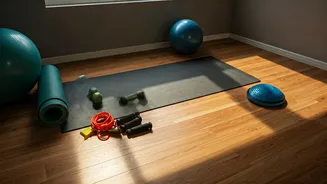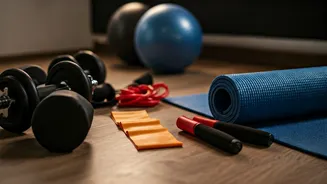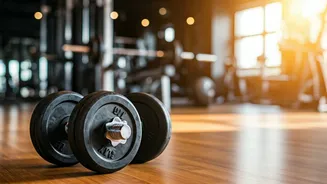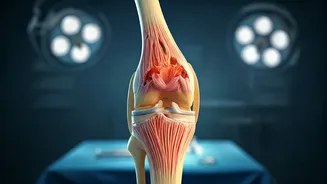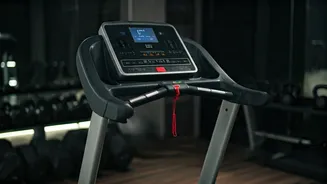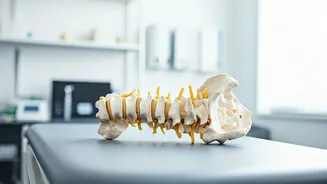Warm-Up: Setting Stage
Before diving into the exercises, a proper warm-up is crucial for preparing your body. Begin with 5-10 minutes of light cardio, such as jogging in place,
high knees, or jumping jacks. This will increase your heart rate and blood flow to your muscles, reducing the risk of injury. Follow this up with dynamic stretching exercises like arm circles, leg swings, and torso twists. This will improve your flexibility and range of motion, which is crucial to getting the most out of the upcoming exercises. Preparing your body properly will increase the effectiveness of the exercise and avoid any pain or potential injuries. The warm-up is a critical part of your routine. Make sure you don't skip it.
Crunches: Core Activation
Crunches are a fundamental exercise for targeting the abdominal muscles. To perform a crunch, lie on your back with your knees bent and feet flat on the floor. Place your hands lightly behind your head, or cross them gently over your chest. Engage your core and lift your upper body towards your knees, keeping your lower back pressed against the floor. Avoid pulling on your neck. Slowly lower back down. Aim for 3 sets of 15-20 repetitions. Ensure you are engaging your core by drawing your belly button towards your spine throughout the movement. Focus on controlled movements, avoiding any jerking or sudden motions. Crunches will target your abdominal muscles, which is a key part of your core strengthening.
Leg Raises: Lower Abs
Leg raises specifically target the lower abdominal muscles. Lie on your back with your legs extended. Place your hands by your sides or slightly under your glutes for support. Keeping your legs straight or slightly bent, slowly lift your legs towards the ceiling, engaging your lower abs. Lower your legs back down with control, but don't let them touch the floor. Aim for 3 sets of 15-20 repetitions. Ensure you are using your abdominal muscles to lift and lower your legs, and not relying on momentum. Avoid swinging your legs. Keep the movement slow and deliberate, and focus on contracting your abdominal muscles. Controlled leg raises are a great way to engage your core.
Plank: Full-Body Stability
The plank is an exceptional exercise for overall core strength and stability. Get into a push-up position, but instead of resting on your hands, support your weight on your forearms. Your body should form a straight line from head to heels. Engage your core, glutes, and legs to maintain this position. Hold for 30-60 seconds, and gradually increase the duration as you get stronger. Aim for 3 repetitions. Make sure to keep your back straight, avoiding sagging in the middle or arching your lower back. Consistent planking helps fortify the abdominal muscles, leading to improved posture and core strength. This is an exercise that works your whole body, not just your core.
Russian Twists: Oblique Workout
Russian twists are designed to work the oblique muscles, which run along the sides of your abdomen. Sit on the floor with your knees bent and feet slightly off the ground, or keep your feet on the ground for a less intense version. Lean back slightly, keeping your back straight, and twist your torso from side to side, touching the floor beside you with your hands or holding a weight. Aim for 3 sets of 15-20 repetitions on each side. Focus on controlled movements and engage your core to rotate. Avoid jerking or rushing through the exercise. Russian twists are a great way to target those stubborn side abdominal muscles. Remember to work both sides to build symmetry.
Bicycle Crunches: Dynamic Core
Bicycle crunches combine elements of crunches and twists for a dynamic core workout. Lie on your back with your hands behind your head and your knees bent. Bring your right elbow towards your left knee while extending your right leg. Then, switch sides, bringing your left elbow towards your right knee while extending your left leg. Continue alternating sides in a cycling motion. Aim for 3 sets of 15-20 repetitions per side. Make sure to engage your core and avoid pulling on your neck. Keeping a consistent pace while focusing on core engagement will help you work the entire abdominal area. This exercise helps your core muscles in a dynamic way.
Mountain Climbers: Cardio Boost
Mountain climbers are a great exercise that combines cardio and core work. Start in a high plank position. Bring your right knee towards your chest, then quickly switch, bringing your left knee towards your chest. Continue alternating your legs as quickly as possible while maintaining good form. Aim for 3 sets of 30-60 seconds. Make sure your core is engaged and your back remains straight throughout the exercise. Keep your head up and focus on the movement. Mountain climbers will not only strengthen your core but will also increase your heart rate. This makes it an ideal exercise to burn calories and shed fat.
Flutter Kicks: Lower Abs
Flutter kicks are a simple yet effective exercise for working your lower abdominal muscles. Lie on your back with your legs extended and a few inches above the floor. Place your hands under your glutes for support. Alternate kicking your legs up and down, keeping them straight. Aim for 3 sets of 30-60 seconds. Maintain a steady pace and focus on engaging your lower abs. Avoid letting your legs touch the floor to keep the tension on your abdominal muscles. This exercise is perfect for targeting and toning your lower abdominal muscles. Consistent practice will help you build stronger core muscles.
Cool-Down: Post-Workout
After completing your workout, it is essential to cool down. Perform static stretches, holding each stretch for 30 seconds. Focus on stretching the muscles you worked during the workout, such as your abs, obliques, and hip flexors. This will help reduce muscle soreness and improve flexibility. Drink plenty of water to rehydrate. Cooling down prevents muscle stiffness, improves flexibility, and helps your body return to its normal state. Doing this properly will help avoid injuries and allows your body to recover properly. Always make sure to cool down after your routine.
